
Ducks in Utah
Utah, with its diverse range of wetland ecosystems, serves as a vital habitat for various duck species, making it a significant area for both resident and migratory waterfowl. The state's strategic position along the Pacific Flyway, a major migratory route for birds in North America, is particularly beneficial for numerous duck species that pass through or reside in Utah. Key areas like the Great Salt Lake and its associated wetlands, as well as numerous rivers and reservoirs, provide essential feeding, breeding, and resting grounds for these birds.
The variety of ducks in Utah includes both dabbling and diving ducks. Dabbling ducks, such as the Mallard, Northern Pintail, and American Wigeon, are frequently seen in the shallow waters of marshes and lakes. They are known for their feeding technique, tipping forward into the water to graze on underwater plants. Diving ducks, like the Lesser Scaup and the Canvasback, frequent deeper waters where they dive below the surface to catch fish and aquatic invertebrates. Each species has its unique adaptations, from bill shapes designed for specific diets to specialized feet for efficient swimming.
Spring and autumn are particularly notable times for observing ducks in Utah, as these are peak migration periods. During spring, many species arrive in Utah to take advantage of the abundant food resources and suitable nesting habitats. Wetlands and water bodies become alive with various duck species, each engaged in their breeding and rearing activities. Males often display vibrant breeding plumages and engage in elaborate courtship behaviors to attract mates. In autumn, as temperatures drop and food becomes scarce in northern regions, ducks migrate southward, with Utah's wetlands providing crucial refueling stops.
Conservation of duck populations in Utah involves habitat preservation and careful management of water resources. Wetlands are among the most productive but also most threatened ecosystems, facing challenges from development, pollution, and changes in water management. Conservation efforts include protecting and restoring these habitats, regulating hunting to ensure sustainable populations, and conducting research to understand the needs and behaviors of different duck species. Through these efforts, Utah continues to be an important refuge for ducks, contributing to the overall health of waterfowl populations in the western United States.
Species Profiles:
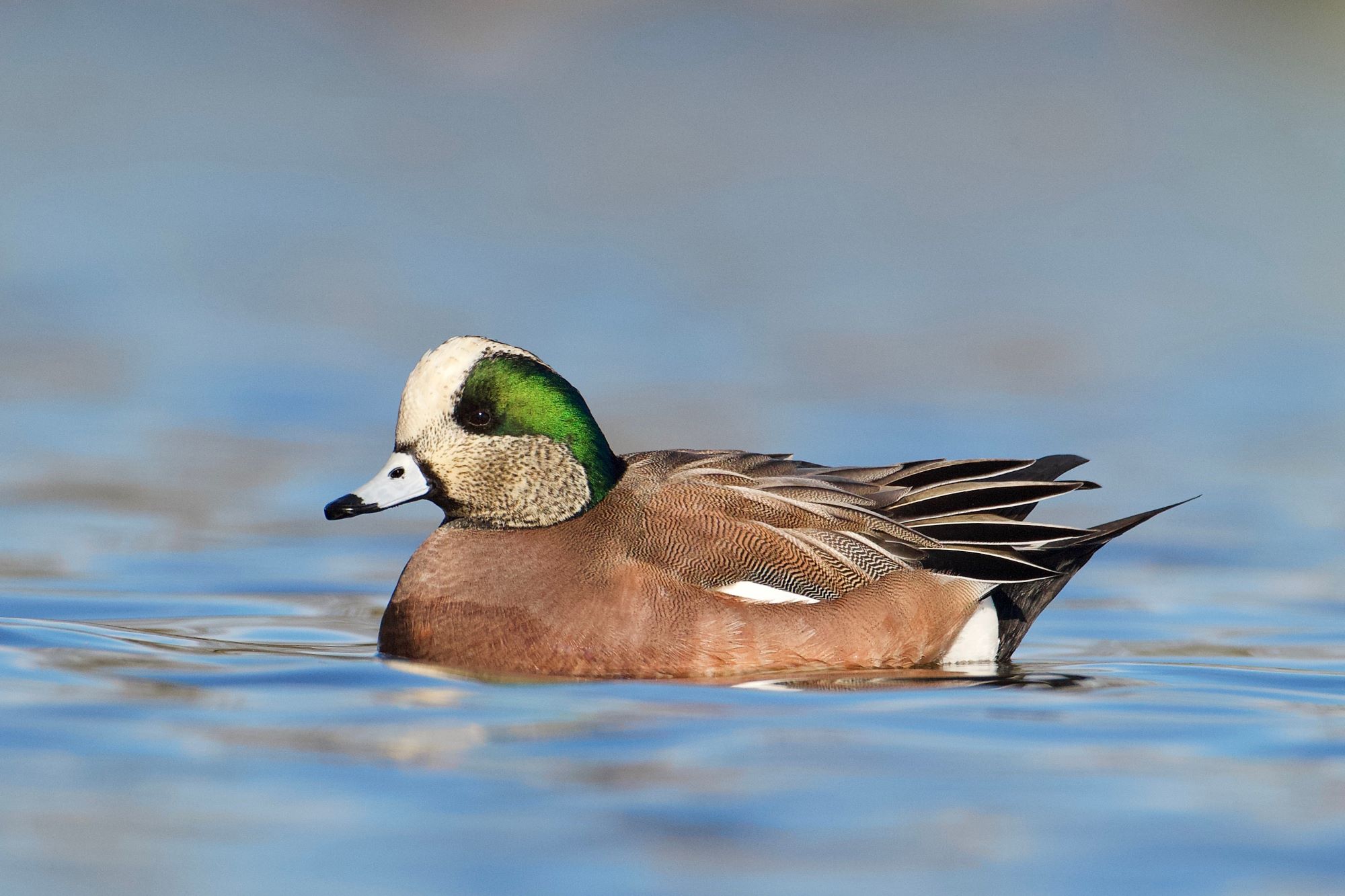
American Wigeon: In Utah, American Wigeons, known scientifically as Mareca americana, grace the state's wetlands and water bodies, particularly during the migration and winter months. Though they breed uncommonly in Utah, their presence in the state is a highlight for birdwatchers and nature enthusiasts. These medium-sized, attractive dabbling ducks are distinguished by their striking plumage – the males with their bold green eye patches and white crowns against russet-colored heads and gray bodies, and the females with more subdued, mottled brown feathering that offers excellent camouflage in aquatic environments. American Wigeons are versatile in their feeding habits, dabbling in shallow waters for aquatic plants and grazing on land for grasses and grains, a trait that sets them apart from many other duck species. This adaptability in diet allows them to thrive in Utah's diverse ecosystems, ranging from freshwater marshes to the shores of larger lakes. Their presence during winter in mixed-species flocks provides a dynamic spectacle, showcasing the rich biodiversity and the importance of these habitats for various migratory waterfowl. The conservation of these wetland areas in Utah is crucial not only for the wellbeing of the American Wigeon populations but also for maintaining the ecological balance and supporting the myriad other species that depend on these habitats.

Barrow's Goldeneye: A striking species of duck, the Barrow's Goldeneye is particularly noted for its presence in Utah. These birds are distinguished by their unique plumage: males display a bold black and white coloration with a distinctive white crescent on their faces, while females are more subdued, featuring brownish bodies and a contrasting white collar. In Utah, Barrow's Goldeneyes are typically found in freshwater habitats, such as the state's lakes, reservoirs, and rivers, particularly in higher elevations. They prefer clear, cold water and are often seen in small flocks, diving for food. Their diet primarily consists of aquatic insects, crustaceans, and small fish. While not as common as some other duck species in Utah, Barrow's Goldeneyes are a notable part of the region's biodiversity, attracting birdwatchers and nature enthusiasts. These ducks are migratory, spending their summers in northern regions for breeding and moving to more temperate areas, including Utah, during the winter. Their presence in Utah's waterways adds a dynamic element to the local ecosystem and offers a glimpse into the diverse avian life that the state supports.
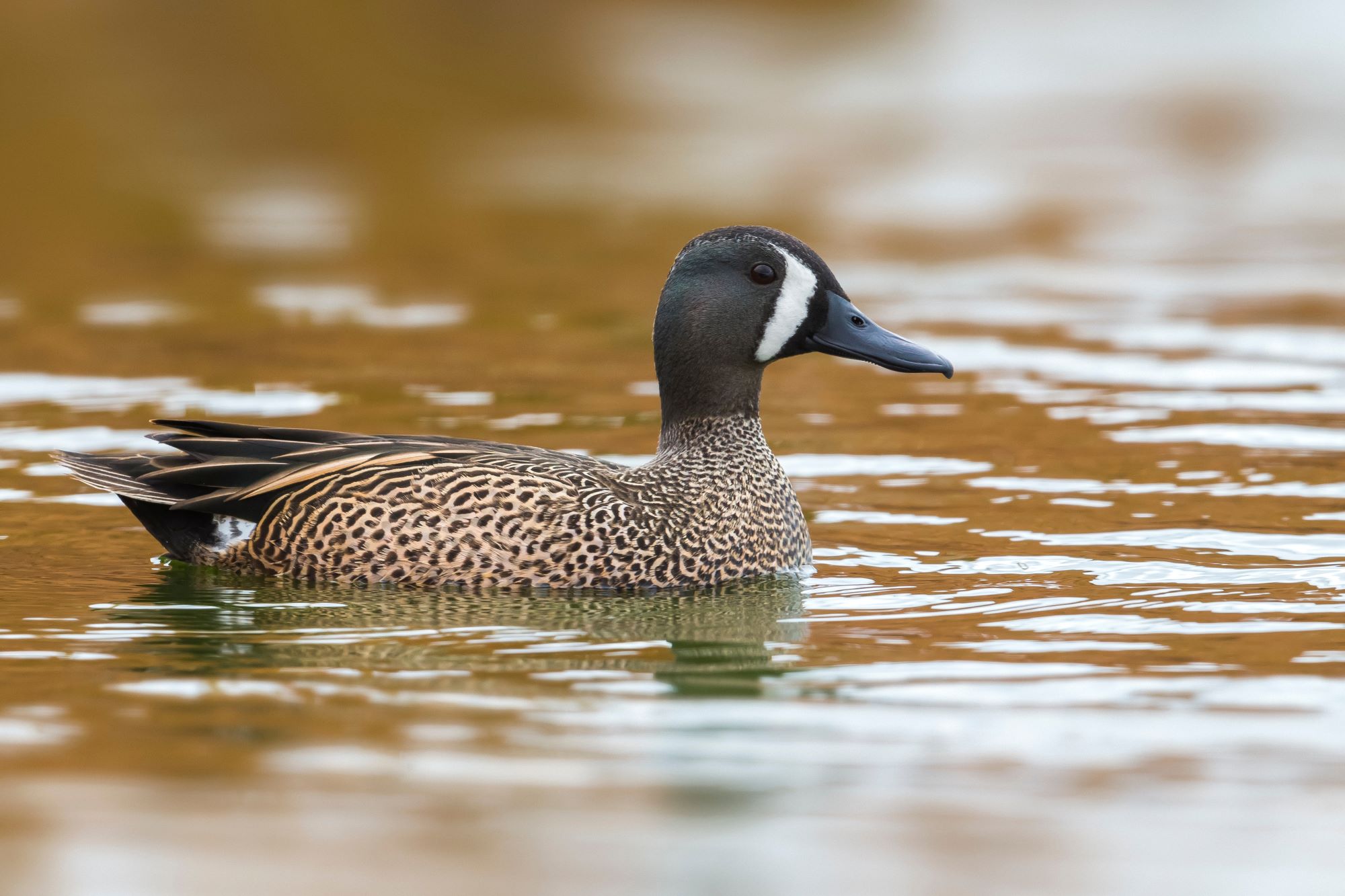
Blue-winged Teal: Small dabbling ducks known for their distinctive wing markings, Blue-winged Teals are a notable part of Utah's diverse bird population. The males of this species are easily recognized during the breeding season by their slate-gray heads and bodies, with a prominent white crescent in front of the eye, and, of course, the bright blue patch on their wings. Females are more subdued in color, with mottled brown plumage that provides excellent camouflage, but they also feature the characteristic blue wing patch. In Utah, Blue-winged Teals are commonly found in shallow wetlands, marshes, and along the edges of ponds and lakes. They prefer habitats with abundant aquatic vegetation, where they feed on seeds, aquatic invertebrates, and plants. These ducks are most prevalent in Utah during the spring and fall migration seasons, as they travel to and from their breeding grounds in the northern United States and Canada. Blue-winged Teals are among the first ducks to head south in the fall and one of the last to return in the spring. Their presence in Utah's wetlands, particularly during migration, adds to the region's avian diversity and offers birdwatchers and nature enthusiasts the opportunity to observe these small yet vibrant ducks. The Blue-winged Teal's migration patterns and habitat preferences highlight the importance of preserving diverse wetland ecosystems in Utah, which provide critical stopover points for many migratory bird species. Their role in the ecosystem as seed dispersers and consumers of aquatic invertebrates underscores the interconnectedness of species and habitats in maintaining ecological balance.
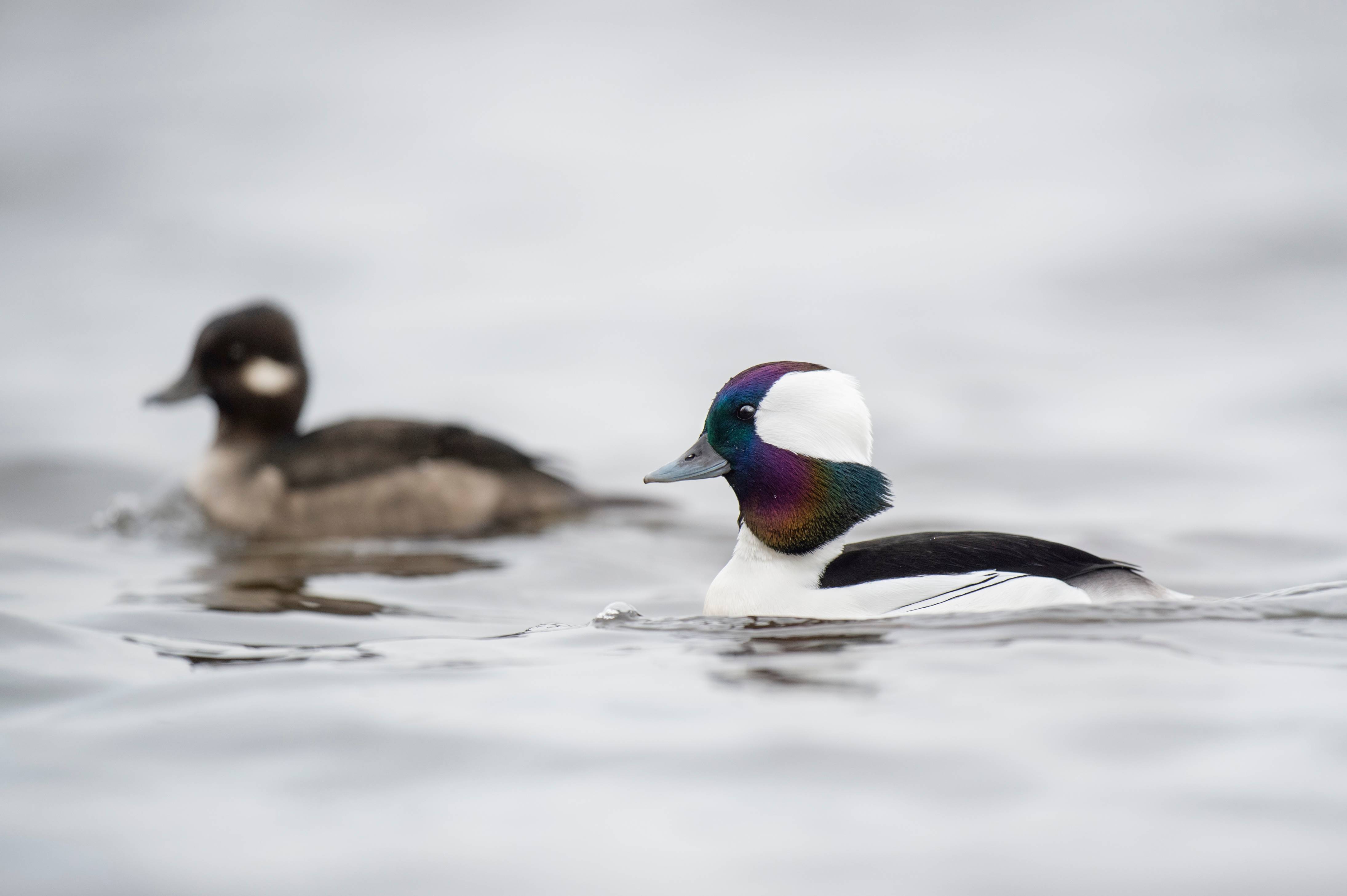
Bufflehead: A small and charismatic species of waterfowl, the Bufflehead is a notable presence in Utah's diverse birdlife. With a striking appearance, the male Bufflehead showcases a bold black and white pattern, featuring a large white patch that wraps around the back of the head, while the female is more understated, predominantly gray-brown with a smaller white cheek patch. These ducks are typically found in the state's various aquatic habitats, including lakes, ponds, and slow-moving rivers. In Utah, Buffleheads are primarily winter visitors, migrating from their breeding grounds in the boreal forests of Canada and the northern United States. During their stay in Utah, which generally spans from late fall through early spring, they are often observed in small flocks, engaging in their characteristic diving behavior to feed on aquatic invertebrates. The presence of Buffleheads in Utah is a testament to the state's suitable wintering habitats that offer the necessary resources for these birds during their non-breeding season. Their agility in water, compact size, and distinct plumage make them a favorite among birdwatchers and nature enthusiasts in the region. The Bufflehead's annual migration and wintering patterns contribute significantly to the ecological diversity and ornithological richness of Utah's waterways.
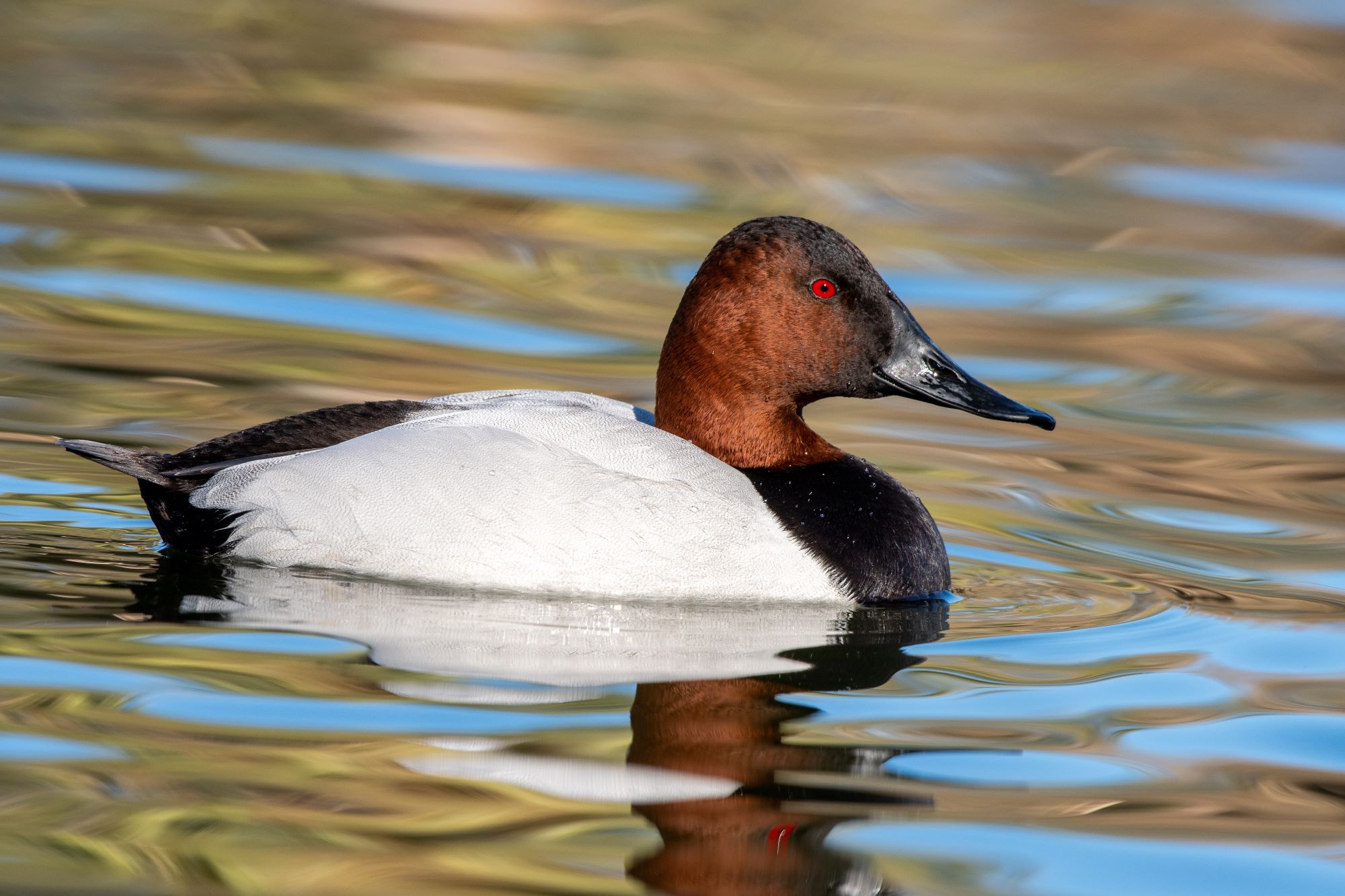
Canvasback: A striking species of diving duck, Canvasbacks are a noteworthy aspect of Utah's birdlife. Recognizable by their distinctive profile, Canvasbacks have sloping foreheads and long, elegant necks. The males are particularly striking with their bright chestnut-red heads, black chests, and light gray bodies, while females are more subdued, featuring brownish heads and grayish bodies. In Utah, these ducks are primarily found in large, open waters such as lakes, reservoirs, and rivers. They are winter visitors, migrating to Utah from their breeding grounds in the prairies of North America. During their stay, typically from late fall to early spring, Canvasbacks are often seen in flocks, gracefully diving for their food, which primarily consists of aquatic plants, seeds, and sometimes small fish and insects. Their preference for deeper water distinguishes them from other duck species in the region. The presence of Canvasbacks in Utah's aquatic environments during the winter months adds a significant dimension to the state's biodiversity. These ducks are not only valued by birdwatchers and wildlife enthusiasts for their beauty and grace but also play an essential role in the ecosystem as consumers of aquatic vegetation, contributing to the health and balance of their habitats. The Canvasback's migration patterns and wintering habits in Utah reflect the state's importance as a crucial stopover and wintering site for various migratory waterfowl species.
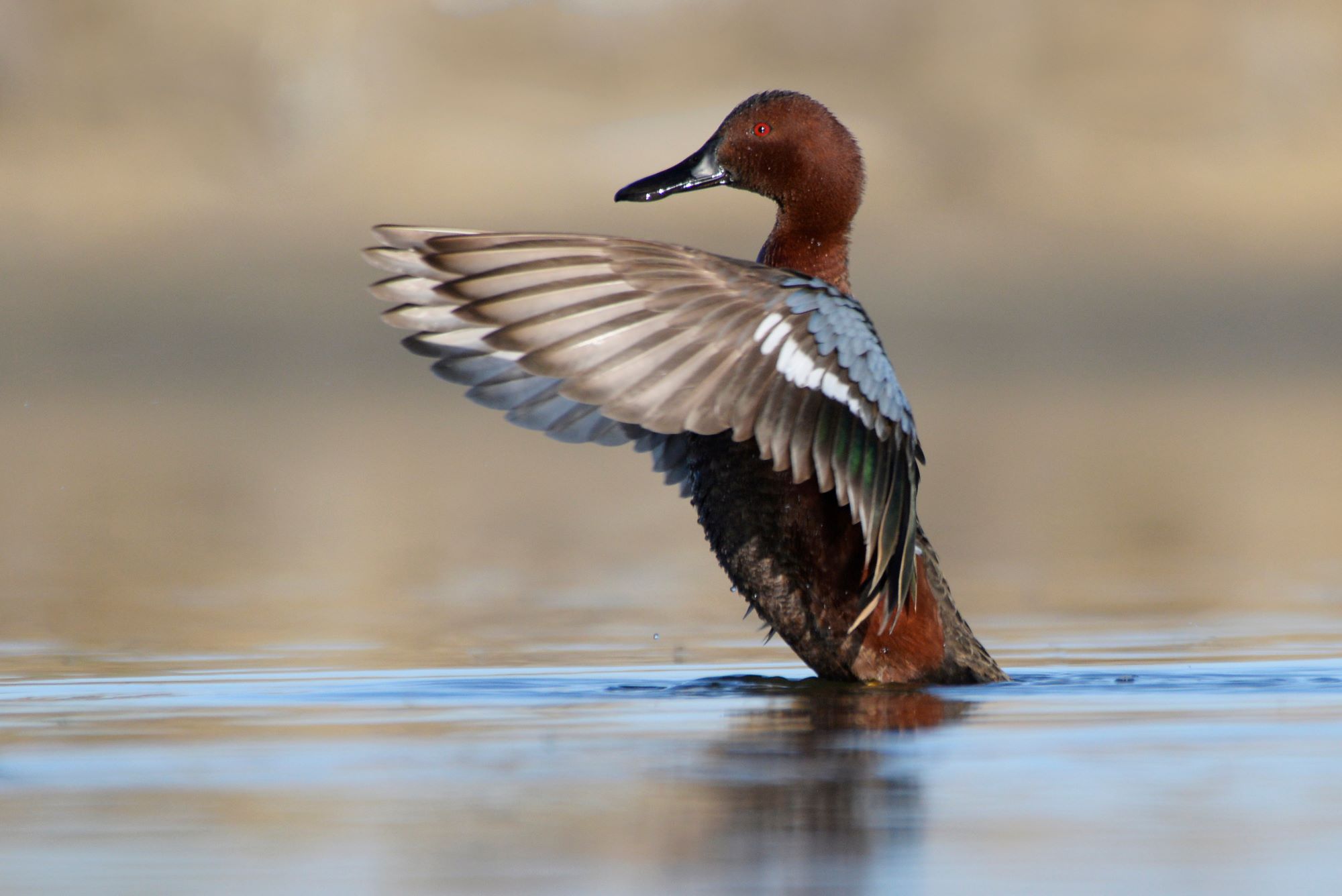
Cinnamon Teal: A vibrant and important part of Utah's avian community, Cinnamon Teals are particularly noted for their striking coloration and habitat preferences. These small dabbling ducks are most recognizable for the rich, cinnamon-red plumage of the males, while the females are mottled brown, offering excellent camouflage in their marshy habitats. In Utah, Cinnamon Teals are commonly found in shallow freshwater marshes, wetlands, and along the edges of lakes and slow-moving rivers, where they feed on a diet of seeds, aquatic plants, and small invertebrates. What makes them particularly special in Utah is their status as one of the first duck species to arrive during the spring migration, often appearing as early as February or March. They are also among the few waterfowl species that breed in the state. Their nesting sites are usually well-concealed in dense marsh vegetation, reflecting their preference for secluded and quiet environments. The presence of Cinnamon Teals in Utah is a strong indicator of the health of wetland ecosystems, as these ducks are sensitive to changes in water quality and habitat conditions. Their vibrant presence during the breeding season, followed by their congregation in larger flocks during the migration periods, adds a dynamic and colorful element to Utah's wildlife, making them a favorite among birdwatchers and nature enthusiasts. As a key species in the local ecosystem, Cinnamon Teals play a vital role in maintaining the ecological balance of Utah's wetlands.
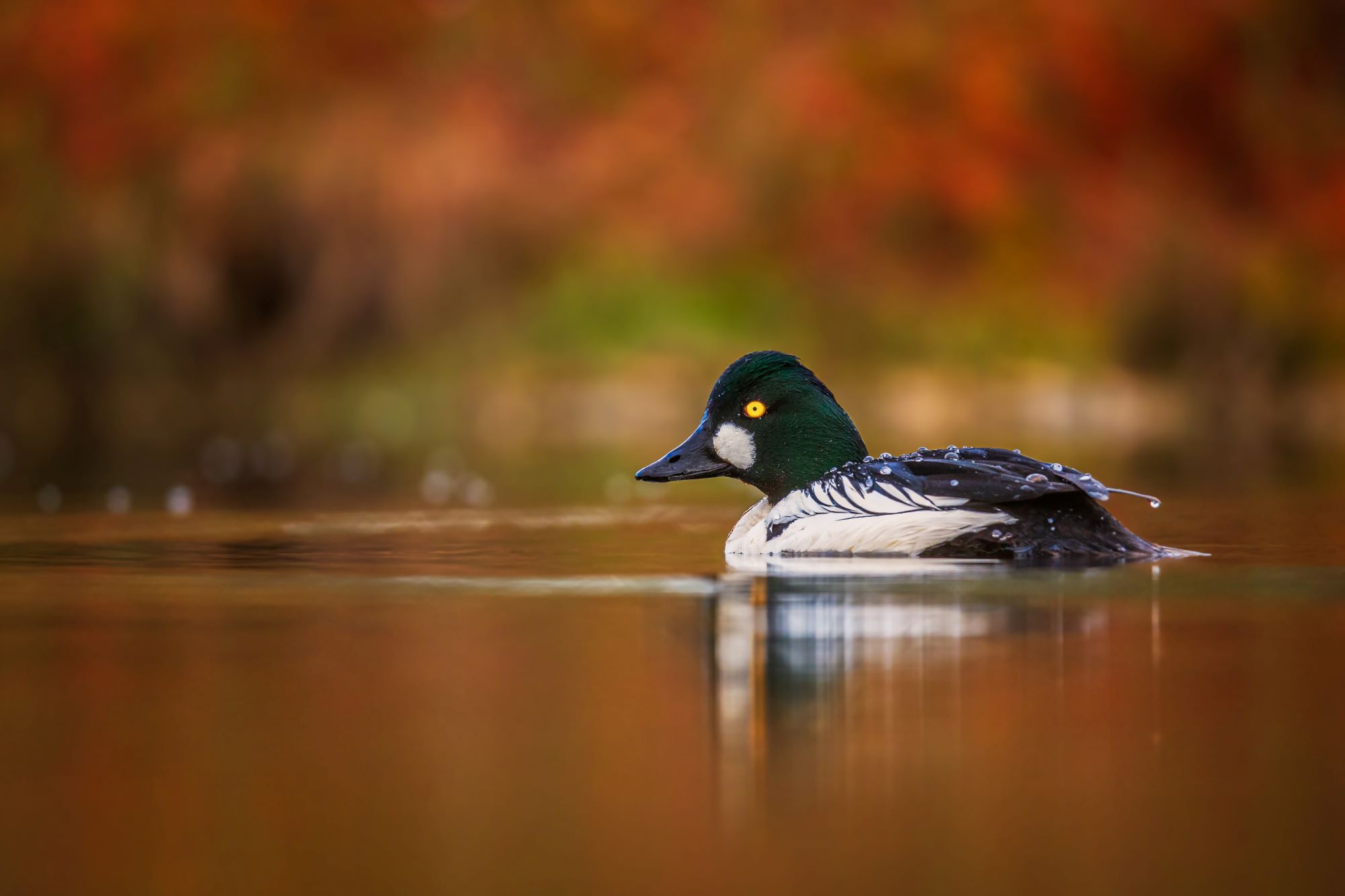
Common Goldeneye: A captivating sight in Utah's avian landscape, Common Goldeneyes are known for their striking appearance and dynamic behavior. These medium-sized ducks are named for their distinctive golden-yellow eyes, which stand out against their otherwise contrasting plumage. Male Common Goldeneyes exhibit a bold pattern with glossy greenish-black heads, a prominent white spot near the base of the beak, and predominantly white bodies with black back. Females, on the other hand, display more muted tones, with brownish heads and gray bodies. In Utah, these ducks are primarily winter visitors, migrating from their breeding grounds in the forested areas of Canada and the northern United States. They typically inhabit open waters of lakes, reservoirs, and rivers, showcasing their prowess in diving as they forage for fish, insects, and crustaceans. Their presence in Utah usually spans from late fall through the winter months into early spring, where they can often be seen in small flocks, sometimes mixed with other species of diving ducks. The arrival of Common Goldeneyes in Utah marks an important seasonal shift in the state's birdwatching calendar, as they add both diversity and visual interest to the local waterways. Their adaptability to various aquatic environments and their distinctive diving behavior make them a fascinating subject for naturalists and bird enthusiasts. The Common Goldeneye's migration patterns and wintering habits in Utah highlight the state's significance as a supportive habitat for various migratory bird species, contributing to the ecological richness of the region.
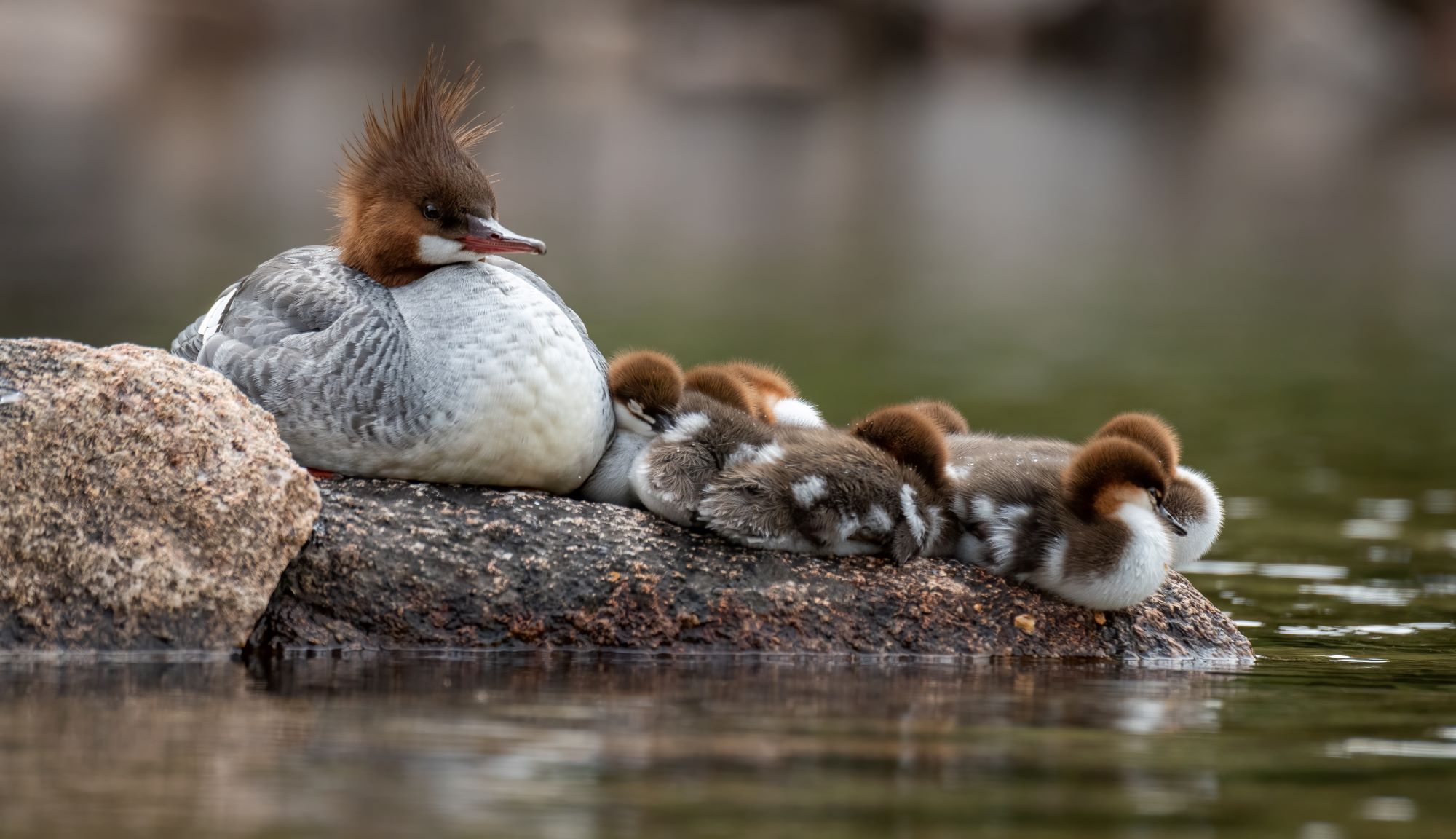
Common Merganser:A distinctive and elegant species of waterfowl, Common Mergansers are a notable feature of Utah's diverse bird population. These large ducks are easily recognized by their slender bodies and long, narrow bills, which are specially adapted for catching fish. Male Common Mergansers exhibit striking plumage, with crisp white bodies, dark green heads, and black backs, while females are characterized by their gray bodies and rusty-cinnamon heads with a distinctive crest. In Utah, these birds are typically found along larger bodies of water such as lakes, reservoirs, and rivers, where they can be seen gracefully swimming or diving for fish, their primary diet. Common Mergansers are both winter visitors and, in some areas, year-round residents of Utah. Their presence is particularly notable during the winter months, when they form large flocks on open waters, often associating with other waterfowl. The Common Merganser plays a vital role in the aquatic ecosystems of Utah, serving as an indicator of water quality and fish population health. These birds are admired by birdwatchers and nature enthusiasts for their beauty and for their impressive diving skills. As a key species in Utah's aquatic habitats, the Common Merganser contributes significantly to the biodiversity and ecological complexity of the region, highlighting the importance of maintaining healthy and diverse waterways for the sustenance of such specialized wildlife.
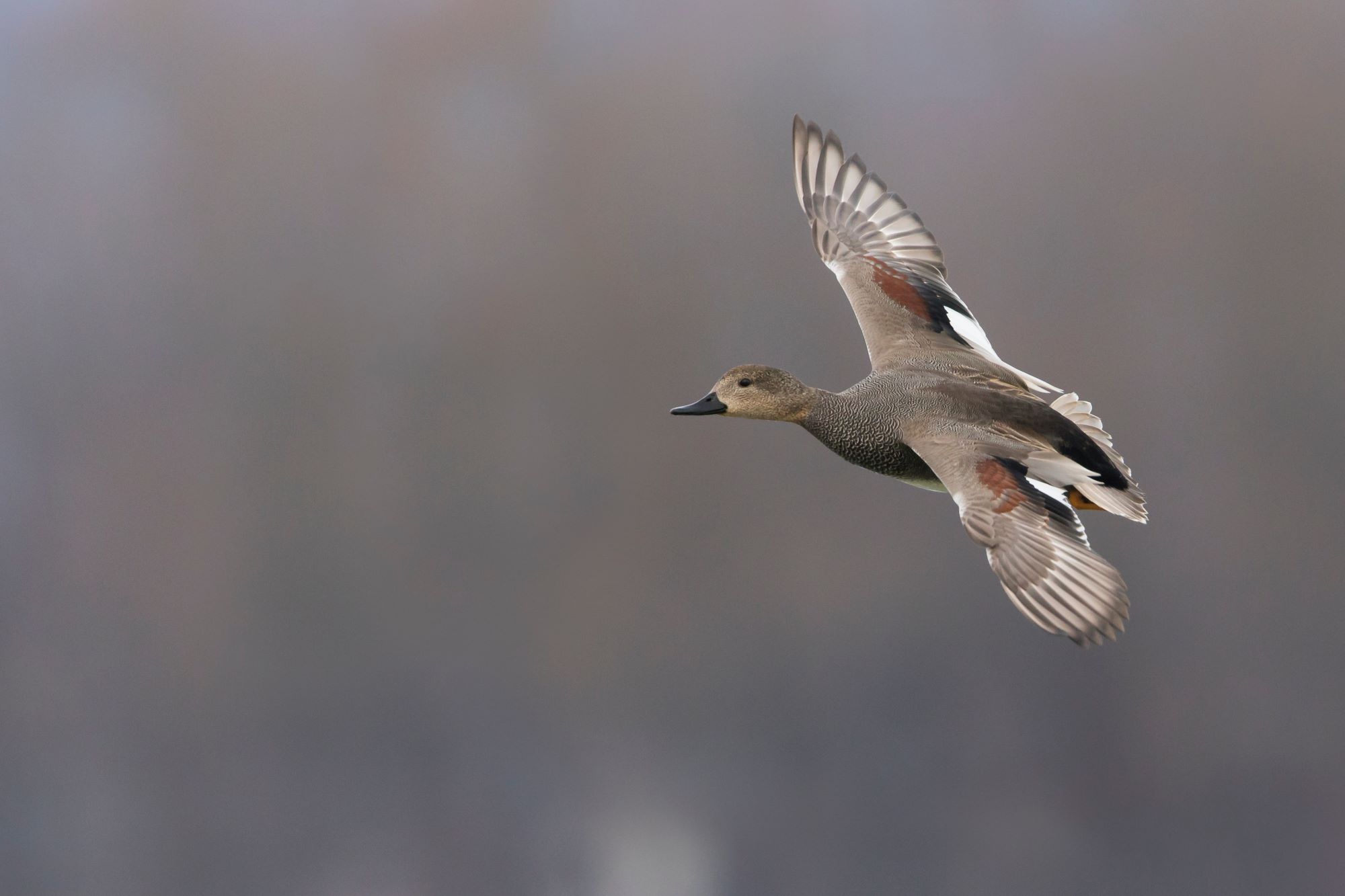
Gadwall: A species of dabbling duck, Gadwalls are a prominent and fascinating aspect of Utah's avian landscape. These medium-sized ducks are characterized by their understated yet elegant plumage. Male Gadwalls display a subtle pattern of gray-brown with black rear ends, and a distinct black bill, while females are mottled brown, offering them excellent camouflage among marsh vegetation. In Utah, Gadwalls are commonly found in a variety of wetland habitats, including marshes, ponds, lakes, and slow-moving rivers. They are adaptable ducks, often seen foraging in shallow waters where they feed on aquatic vegetation and invertebrates by 'tipping up' their tails and submerging their heads. While Gadwalls are present in Utah year-round, their population increases significantly during the winter months due to migration. They are among the first waterfowl to return to their breeding grounds in the spring, making their presence a herald of the changing seasons. Gadwalls are particularly notable for their quiet, unobtrusive behavior, which, along with their cryptic coloration, often allows them to go unnoticed. Their breeding behavior is also of interest, as they often nest in dense vegetation near water, showing a preference for seclusion. The presence of Gadwalls in Utah contributes to the diversity of the state's bird species and underscores the importance of conserving varied wetland habitats to support a range of wildlife, including less conspicuous yet ecologically important species like the Gadwall.

Greater Scaup: A species of diving duck, Greater Scaups hold a notable presence in Utah's waterfowl community, especially during the winter months. Characterized by their rounded heads and bright blue bills, the male Greater Scaups boast a striking appearance with glossy black heads, white sides, and black tails. Females are more subdued, with brown plumage and white patches near their bills. In Utah, these ducks are typically found in larger bodies of water, such as lakes, reservoirs, and occasionally on large rivers. They prefer deep, open water environments where they dive skillfully to feed on a diet of mollusks, crustaceans, and aquatic plants. Greater Scaups are primarily winter visitors in Utah, arriving from their breeding grounds in the northern tundra regions of North America and Eurasia. Their presence in the state is a significant aspect of the winter birdwatching scene, as they often form large flocks that can be seen resting or feeding on the water. The Greater Scaup's robust diving ability and preference for deeper water habitats differentiate them from other duck species in the area. Their migration patterns and wintering behavior in Utah highlight the state's role in providing critical habitats for a variety of waterfowl species during the colder months. As a part of Utah's diverse ecosystem, Greater Scaups contribute to the ecological richness of the region's aquatic environments, underscoring the importance of conserving these habitats for the sustenance of migratory waterfowl populations.

Green-winged Teal: The smallest of North American dabbling ducks, Green-winged Teals are a vibrant and important part of Utah's avian landscape. These petite ducks are distinguished by their striking plumage: males have a chestnut head with a broad green stripe extending from the eye to the back of the neck, a speckled brown body, and a namesake green patch on their wing. Females are mottled brown overall, providing excellent camouflage in their marshy habitats. In Utah, Green-winged Teals are frequently found in shallow wetlands, marshes, and along the edges of ponds and lakes. They are adept at foraging in shallow water, tipping up to feed on seeds, aquatic plants, and small invertebrates. While some Green-winged Teals can be found in Utah year-round, their numbers significantly increase during the winter and migration seasons, as they travel to and from their northern breeding grounds. Their presence in Utah is a key indicator of healthy wetland ecosystems, as these birds rely on high-quality water and abundant food resources. During the breeding season, they exhibit interesting courtship behaviors, including intricate displays and vocalizations. The arrival of Green-winged Teals in Utah, especially during migration, adds a dynamic element to the state's birdwatching opportunities, attracting enthusiasts eager to observe these small but vividly colored ducks. Their presence enhances the biodiversity and ecological complexity of Utah's wetland environments, underscoring the importance of protecting these crucial habitats for the sustenance of diverse wildlife populations.

Hooded Merganser: A striking and somewhat elusive species of waterfowl, Hooded Mergansers are a notable addition to Utah's rich birdlife. These small, diving ducks are immediately recognizable by their distinctive crests: males feature large white crests bordered with black, set against a background of glossy black and brown plumage, while females have smaller, reddish-brown crests. In Utah, Hooded Mergansers are primarily found in wooded ponds, lakes, and slow-moving rivers, where they prefer areas with abundant aquatic vegetation. They are adept at diving and foraging for fish, insects, and crustaceans, which comprise the bulk of their diet. Hooded Mergansers are typically seen in Utah during the winter months, as they migrate south from their breeding grounds in the forests of North America. Their presence in the state, although not as common as some other waterfowl species, is always a delightful sight for birdwatchers and nature enthusiasts. These ducks are particularly interesting for their breeding behaviors; they are cavity nesters, often using holes in trees or nest boxes. The appearance of Hooded Mergansers in Utah's waterways adds a unique and intriguing aspect to the local ecosystem. Their specialized feeding habits and preference for specific habitats make them important indicators of the health and diversity of aquatic ecosystems. The conservation of suitable wetland and wooded habitats in Utah is crucial for supporting the wintering populations of this and other waterfowl species, thereby maintaining the ecological balance and biodiversity of the region.

Lesser Scaup: Often referred to as "Little Bluebills," Lesser Scaups are a common and vibrant feature of Utah's waterfowl community, particularly noted for their adaptability and distinctive appearance. These medium-sized diving ducks are characterized by their round heads and bright blue bills. The males display striking plumage with glossy black heads, white sides, and black backs, while the females are more subdued, with brownish bodies and white patches near their bills. In Utah, Lesser Scaups are frequently observed in a variety of aquatic habitats, including lakes, reservoirs, and large ponds, where they dive for their food, primarily consisting of mollusks, aquatic invertebrates, and plant material. They are most prevalent in the state during the winter and migration seasons, arriving from their northern breeding grounds. Lesser Scaups often form large flocks on open water, which can be a spectacular sight for birdwatchers and nature enthusiasts. Their presence in Utah is not only significant for local biodiversity but also for their role as indicators of the health of aquatic ecosystems. These ducks are sensitive to changes in water quality and habitat conditions, making their populations an important gauge for environmental health. The Lesser Scaup's ability to thrive in Utah's varied waterways reflects the state's importance as a crucial habitat for migratory and wintering waterfowl, underscoring the need for conservation efforts to maintain these vital ecosystems. As a part of the state's ecological tapestry, Lesser Scaups contribute to the dynamic interplay of species and habitats that characterize Utah's natural landscape.

Mallard: Perhaps the most recognizable and widespread species of duck, Mallards are a central feature of Utah's avian landscape. These adaptable ducks are known for their striking dimorphic plumage: the males display an iconic green head, a white ring around the neck, and a chestnut-brown chest, while the females are mottled brown, providing them with excellent camouflage. Mallards are a common sight in a variety of aquatic habitats across Utah, including lakes, ponds, rivers, and marshes. They are dabbling ducks, often seen feeding at the water's surface or tipping forward to graze on underwater vegetation and invertebrates. In Utah, Mallards are both year-round residents and migratory visitors, with their numbers swelling during the migration seasons as birds from northern breeding grounds pass through or settle in for the winter. Their presence is significant for local ecosystems, as they play a vital role in seed dispersal and aquatic vegetation control. Mallards are also a popular species among birdwatchers and hunters alike, and their adaptability to human-altered landscapes has enabled them to thrive in urban and suburban areas as well. The Mallard's ubiquitous nature in Utah's waterways makes it a familiar and beloved part of the state's natural heritage, symbolizing the importance of wetland conservation for the maintenance of biodiversity and ecological balance in the region.
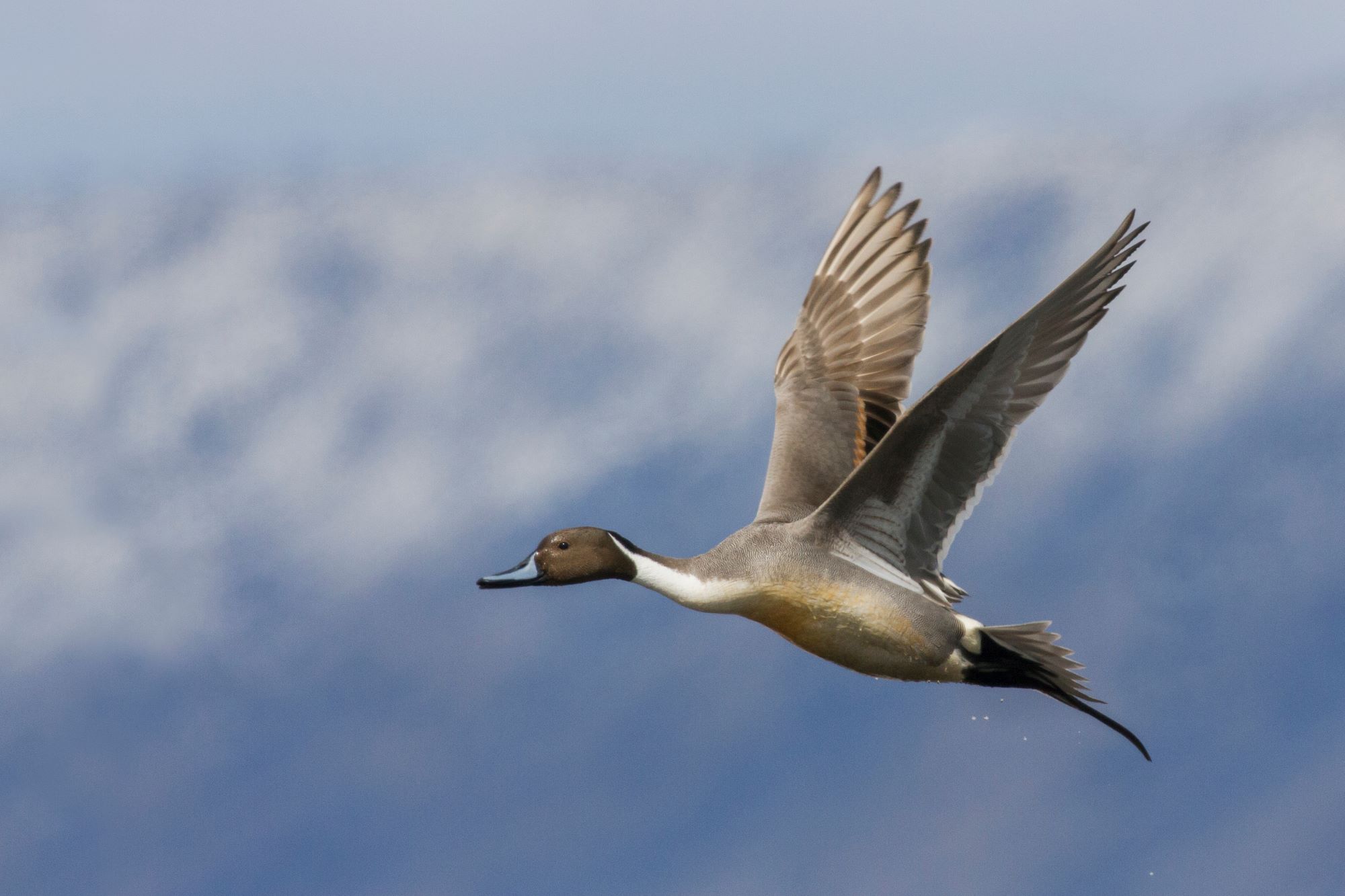
Northern Pintail: With their elegant silhouette and distinctive plumage, Northern Pintails are a graceful and notable feature of Utah's bird population. These slender ducks are easily recognized by their long, pointed tails, from which their name derives. Male Northern Pintails are particularly striking, with a white breast, chocolate-brown head, and white stripe extending up the neck, contrasted by grayish bodies. Females are more subtly colored, with mottled brown plumage that provides excellent camouflage in their nesting habitats. In Utah, Northern Pintails are commonly found in a variety of wetland environments, including marshes, lakes, and rivers. They are adept foragers, often seen dabbling for plant material and invertebrates in shallow waters. These ducks are important migratory visitors in Utah, arriving from their breeding grounds in the northern regions of North America and Eurasia. During their stay, typically from fall to spring, Northern Pintails add to the biodiversity of Utah's waterfowl community. Their elegant flight, long necks, and unique tail feathers make them a favorite among birdwatchers and nature enthusiasts. Northern Pintails play a crucial role in the ecosystem as they help in the dispersal of plant seeds and control of aquatic invertebrates. Their presence in Utah highlights the importance of maintaining healthy and diverse wetland habitats, as these areas are critical for the survival and breeding of migratory waterfowl species. The Northern Pintail's seasonal movements and habitat preferences underscore the interconnectedness of global ecosystems and the need for conservation efforts across their migratory range.

Northern Shoveler: Known for its distinctive large and spatulate bill, the Northern Shoveler is a fascinating species in Utah's avian community. Males are striking, with iridescent green heads, white chests, and rust-colored sides, while females are mottled brown, blending well with their surroundings. This unique bill shape is not just a visual characteristic but a highly specialized tool for feeding; it allows them to sift through water for plankton, seeds, and small invertebrates, a process known as 'dabbling.' In Utah, Northern Shovelers frequent a variety of wetland habitats, including marshes, lakes, and ponds, often seen in groups, swirling around in the water to create feeding currents. They are primarily winter visitors in Utah, migrating from their breeding grounds in the northern parts of North America and Eurasia. Their presence in the state significantly increases during the migration seasons, providing a spectacular view for birdwatchers and nature enthusiasts. The Northern Shoveler's feeding habits play a critical role in the ecosystem, as they help to maintain healthy aquatic environments by controlling invertebrate populations and aiding in nutrient distribution. Their behavior and habitat preferences make them an excellent indicator species for wetland health. The Northern Shoveler's adaptation to diverse wetland environments in Utah showcases the ecological richness of the region and underscores the importance of protecting these crucial habitats to support a wide array of wildlife, including distinctive species like the Northern Shoveler.
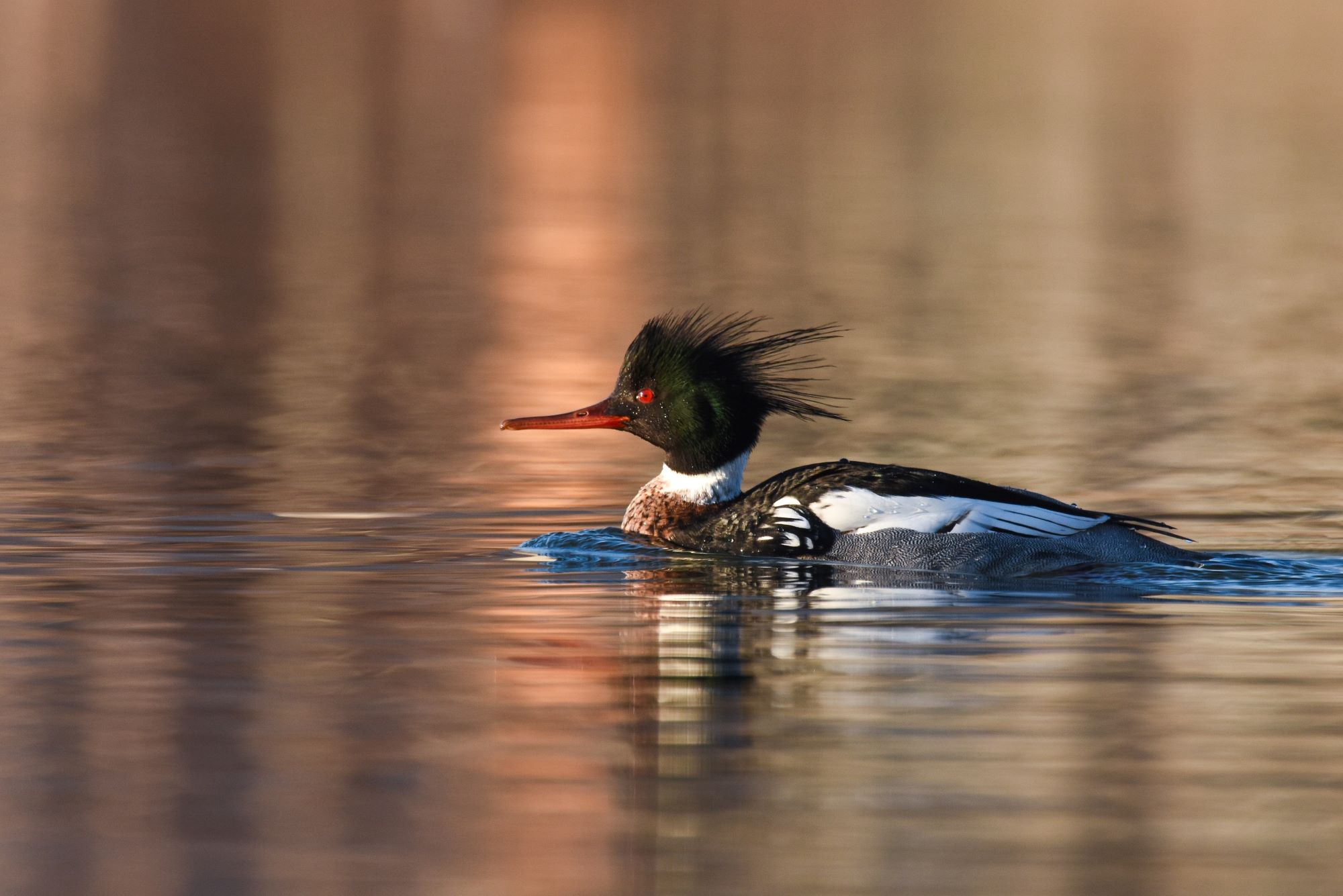
Red.breasted Merganser: A striking and somewhat less common species of waterfowl, Red-breasted Mergansers add a distinct flair to Utah's bird diversity. These ducks are known for their slender, elongated bodies and serrated bills, which are perfectly adapted for catching fish. Male Red-breasted Mergansers are characterized by their dark green heads, a distinct white ring around the neck, and a rusty-red breast, while females display a more subdued grayish body with a rusty head and a shaggy crest. In Utah, these birds are primarily found in large, open water bodies such as lakes and reservoirs, where they exhibit their remarkable diving skills. They are particularly adept at hunting fish, which forms the bulk of their diet, making them excellent indicators of aquatic health. Red-breasted Mergansers are typically seen in Utah during the winter months, as they migrate from their breeding grounds in the northern regions of North America and Eurasia. Their presence in the state, though not as numerous as some other waterfowl species, is nonetheless significant for birdwatchers and nature enthusiasts, who are drawn to their unique appearance and dynamic foraging behavior. The Red-breasted Merganser’s choice of habitat and migratory patterns underscore the importance of maintaining and conserving large aquatic ecosystems in Utah, which serve as crucial stopovers and wintering grounds for various migratory bird species. Their presence enhances the ecological diversity of Utah's waterways, highlighting the interconnectedness of ecosystems and the need for holistic environmental stewardship.

Redhead: A striking species of diving duck, Redheads are a vibrant part of Utah's diverse birdlife, particularly noted for their bold coloring and distinct behavior. Males exhibit a bright chestnut-red head and neck, contrasting sharply with their black chest and light gray body, while females are more subtly colored, with brownish bodies and paler heads. In Utah, Redheads are often found in large wetlands, lakes, and reservoirs, where they dive skillfully for their food, mainly consisting of aquatic plants, seeds, and occasionally small invertebrates. These ducks are primarily winter visitors in Utah, migrating from their breeding grounds in the prairies and marshlands of North America. Their presence in the state typically spans from late fall to early spring. Redheads are known for their unique nesting behavior; they often lay eggs in the nests of other duck species, particularly Canvasbacks and Northern Pintails, a practice known as brood parasitism. The arrival of Redheads in Utah's waterways during the winter months adds significant diversity to the local avifauna, attracting birdwatchers and wildlife enthusiasts. Their robust diving abilities and the ecological role they play in wetland habitats make them important indicators of the health of these ecosystems. Redheads contribute to the ecological richness of Utah's aquatic environments, underscoring the importance of maintaining and protecting these vital habitats for sustaining diverse and dynamic waterfowl populations.
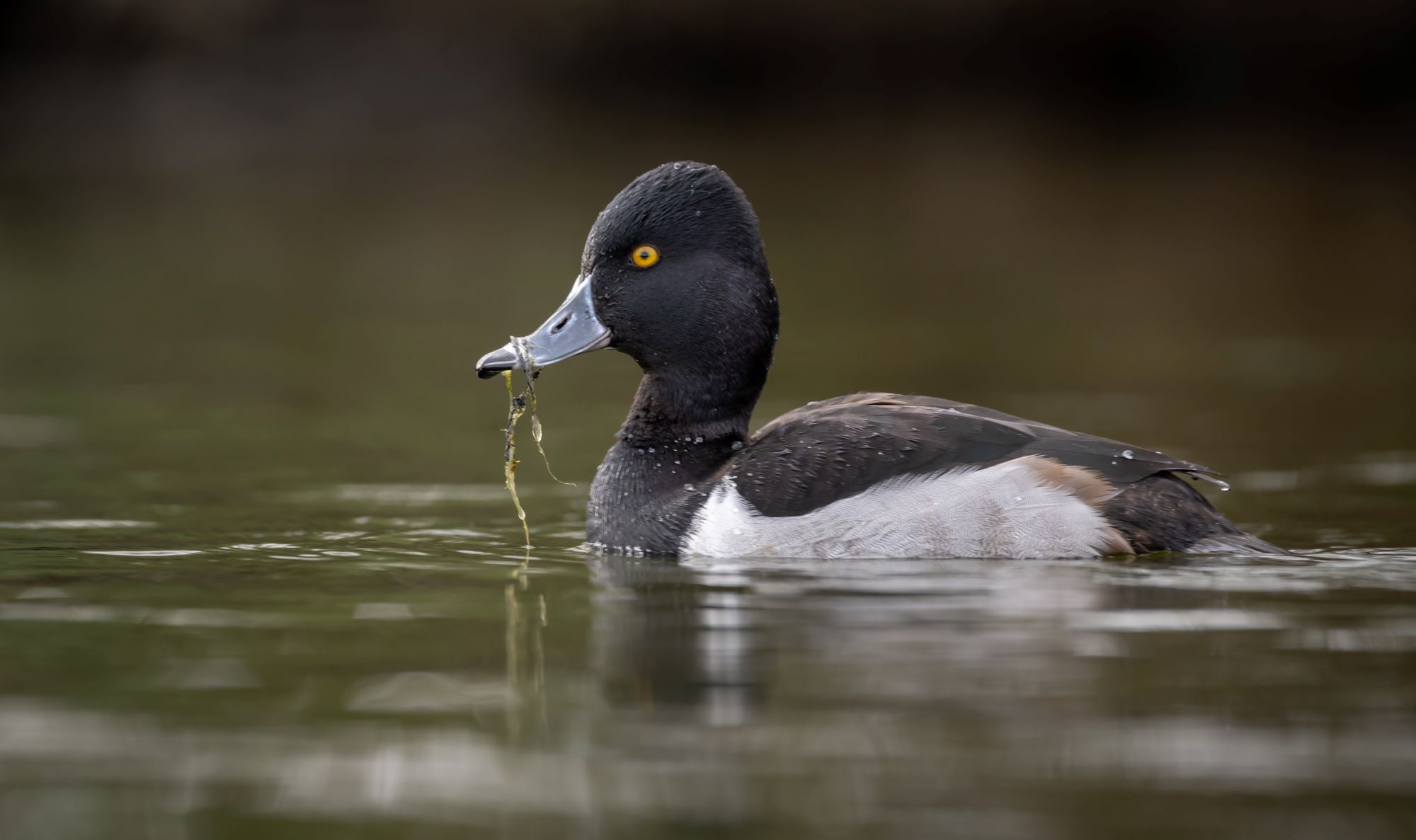
Ring-necked Duck: A distinctive and elegant species of waterfowl, Ring-necked Ducks are a notable feature in Utah's diverse bird population. Despite their name, the most prominent feature of these ducks is not the subtle ring around their neck, but rather the bold white ring around the bill and the contrasting plumage. Male Ring-necked Ducks have striking glossy black heads, backs, and chests, with gray sides and a white vertical stripe on the flank. Females are more subdued, with brownish bodies and a white ring around the bill, similar to the males. In Utah, these ducks are commonly found in freshwater habitats like lakes, ponds, and reservoirs, particularly those with abundant aquatic vegetation. They are diving ducks, adept at foraging underwater for seeds, aquatic plants, and small invertebrates. Ring-necked Ducks are mostly winter visitors in Utah, arriving from their breeding grounds in the northern forests and wetlands of North America. They typically form small flocks and can be seen diving or floating in open water. Their presence in Utah during the winter months adds to the biodiversity of the state's avian community, attracting birdwatchers and nature enthusiasts. The Ring-necked Duck's preference for specific types of aquatic environments makes them valuable indicators of the health of these ecosystems. As part of the ecological fabric of Utah's wetlands, Ring-necked Ducks play an important role in maintaining the balance within these habitats, highlighting the need for conservation and sustainable management of these vital natural resources.

Ruddy Duck: With their distinctive, bold appearance,Ruddy Ducks are a notable and colorful addition to Utah's rich tapestry of birdlife. These small, stout diving ducks are most recognizable during the breeding season when males exhibit bright chestnut bodies, sky-blue bills, and striking black-and-white faces. Females and non-breeding males are more subdued, with mottled brown plumage and darker bills. In Utah, Ruddy Ducks are frequently found in marshes, lakes, and ponds, where they prefer habitats with dense aquatic vegetation. These ducks are adept at diving to feed on aquatic invertebrates and plant seeds, often remaining submerged for considerable lengths of time. Ruddy Ducks are present in Utah throughout the year, but their numbers increase significantly during the migration seasons as birds from other regions come to the state. They are known for their somewhat quirky behavior, including their stiff-tailed posturing and unique courtship displays involving bubbling sounds and striking water with their bills. The presence of Ruddy Ducks in Utah's waterways adds a vibrant dynamic to the local ecosystem. They are an important species for birdwatchers and nature enthusiasts, who are often captivated by their unique appearance and behaviors. The Ruddy Duck's breeding and feeding habits make them valuable indicators of the health of wetland habitats in Utah, emphasizing the need for conservation and protection of these critical ecosystems. As part of the diverse community of waterfowl in the region, Ruddy Ducks contribute to Utah's biodiversity and the ecological balance of its wetland environments.

Wood Duck: Renowned for their striking appearance and unique habitat preferences, WoodDucks are a cherished part of Utah's birdlife. Male Wood Ducks boast a spectacular array of colors: iridescent green and purple heads adorned with white stripes and a crest, red eyes, and ornate chestnut and black bodies. Females are more subtly colored but equally beautiful, with gray-brown bodies, white spectacles around their eyes, and a distinctive white throat patch. These ducks are commonly found in wooded swamps, streams, and ponds within Utah, preferring habitats with dense tree cover and access to water. They are one of the few North American duck species equipped with strong claws for perching on branches and nesting in tree holes. In Utah, Wood Ducks are primarily seen during the breeding and migration seasons. They are cavity nesters, often using nest boxes provided in wetland areas. Their diet consists of seeds, fruits, insects, and other small aquatic creatures. The presence of Wood Ducks in Utah is a delightful treat for birdwatchers and nature enthusiasts, as they add both beauty and ecological diversity to the state's wetlands. Their dependence on specific habitat types makes them important indicators of healthy forested wetland ecosystems. The Wood Duck's successful comeback from near extinction in the early 20th century, largely due to conservation efforts like habitat protection and the provision of nest boxes, is a testament to the effectiveness of wildlife management and conservation strategies. Their continued presence in Utah underscores the importance of maintaining and enhancing the natural habitats that support such diverse and visually stunning wildlife.